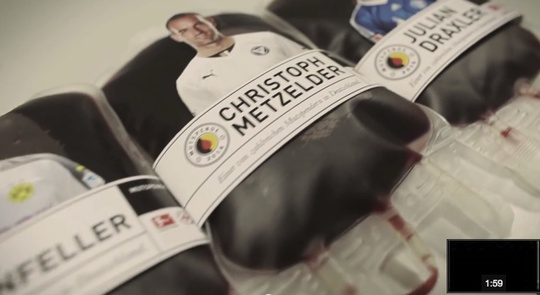Southwest Goes International, Frontier Goes Cheap
Posted in: Uncategorized– Southwest Airlines is getting its passport and has launched a new campaign to tout its first international flights.
– Frontier Air is out with three new ads touting its super low, ala carte fares. And they’re up about charging extra for checking your bags, selecting a seat and even the food and beverage. One. Two. Three.
– Working with Publicis London, Friend London has produced a beautiful, 8-minute documentary for Tourism Ireland.
– US advertisers will collectively spend upwards of $50 billion on digital advertising in 2014, according to new figures from eMarketer. This represents the fifth year in a row of growth. 35% of digital spend will be allocated to mobile. Direct response is front and center.
– Movie stars go gaga for Samsung’s new curved TV.
Wuwei: No Trying, No Doing
Posted in: UncategorizedThe power of spontaneity.
From Adbusters #113: Blueprint for a New World, Part 2: Eco

In a famous story from ancient Chinese philosophy, Butcher Ding has been called upon to play his part in a traditional religious ceremony. The ritual, to consecrate a newly cast bronze bell, requires the butcher to sacrifice an ox in a public space, with the ruler and a large crowd looking on.
The still smoking bell is brought fresh from the foundry and cooled with the blood of the sacrificial animal — a procedure that demands precise timing and perfectly smooth execution. Butcher Ding is up to the task, dismembering the massive animal with effortless grace: “At every touch of his hand, every bending of his shoulder, every step of his feet, every thrust of his knee — swish! swoosh! He guided his blade along with a whoosh, and all was in perfect tune.” Ding’s body and blade move in such perfect harmony that a seemingly mundane task is turned into an artistic performance. When questioned later by Lord Wenhui, the village master, about his incredible skill, Butcher Ding explains, “What I, your humble servant, care about is the Way [Dao].” He then launches into an explanation of what it feels like to perform in such a state of perfect ease:
When I first began cutting up oxen, all I could see was the ox itself. After three years, I no longer saw the ox as a whole. And now, I meet it with my spirit and don’t look with my eyes. My senses and conscious awareness have shut down and my spiritual desires take me away. I follow the Heavenly pattern of the ox, thrusting into the big hollows, guiding the knife through the big openings, and adapting my motions to the fixed structure of the ox. In this way, I never touch the smallest ligament or tendon, much less a main joint.
The result is that Butcher Ding is not so much cutting up the ox as releasing its constituent parts, letting the razor-sharp edge of his cleaver move through the spaces between the bones and ligaments without encountering the slightest resistance.
Occasionally Butcher Ding’s effortless dance is interrupted when he senses trouble, at which point his conscious mind seems to re-engage a bit, though he still remains completely relaxed and open to the situation confronting him: “Whenever I come to a knot, I see the difficulty ahead, become careful and alert, focus my vision, slow my movements and move the blade with the greatest subtlety, so that the ox simply falls apart, like a clod of earth falling to the ground.” Lord Wenhui clearly sees something in this account that goes far beyond simply cutting up oxen. “Wonderful!” he exclaims. “From the words of Butcher Ding, I’ve learned how to live my life!”
This story of Butcher Ding comes from a book called the Zhuangzi, an important work of Daoist philosophy, and one that is principally concerned with a value known as wuwei, or effortless action. Wuwei literally translates as “no trying” or “no doing,” but it’s not at all about dull inaction. In fact, it refers to the dynamic, spontaneous and unselfconscious state of mind of a person who is active and optimally effective. For a person in wuwei, proper and effective conduct follows as automatically as the body gives in to the seductive rhythm of a song. This state of harmony is both complex and holistic, involving as it does the integration of the body, the emotions and the mind. Just as Butcher Ding’s blade remains razor-sharp because it never touches a bone or ligament — moving only through the gaps in between — the person who attains wuwei moves only through the open spaces in life, avoiding the difficulties that damage one’s spirit and wear out one’s body.
The preoccupation with how to cultivate wuwei was at the center of early Chinese controversies about how to attain the good life. Characterizations of wuwei in other early Daoist texts, such as the Laozi, take the form of concise, cryptic poems preoccupied with the “Way of Heaven.” The Laozian sage attains wuwei by simply relaxing into the “Way,” which is a sort of preexisting harmony with nature. The Daoist poems are characterized by an effortless ease that also plays a central role in early Confucianism. This may come as a surprise, because Confucianism is typically associated with hidebound traditionalism and stuffy ritual, which strike us as the opposite of wuwei. In the early stages of training, an aspiring Confucian gentleman needs to memorize entire shelves of archaic texts, learn the precise angle at which to bow and learn the exact length of the steps with which he is to enter a room. All of this rigor and restraint, however, is ultimately aimed at producing a cultivated, but nonetheless genuine, form of spontaneity.

We have all experienced this combination of effortlessness and effectiveness at some point in our lives. While we are completely absorbed in chopping and sautéing, a complex dinner assembles itself before our eyes. Fully relaxed, we breeze through an important job interview without even noticing how well it’s going.
Colloquially, we often speak of ourselves as if we were split in two: “I couldn’t make myself get out of bed this morning,” “I had to force myself to be calm,” “I had to hold my tongue.” Although we use such phrases all the time, if you think about them they’re a bit weird. Who is the self who doesn’t want to get out of bed, and what is its relationship to me? Does my tongue really have a will of its own, and how do I go about holding it? (And who am I if not my tongue?) Since there is always only one “me” involved, this split-self talk is clearly metaphorical rather than literal. Talk of split selves is certainly not limited to English: we can see it in many wuwei stories from early China that involve a narrative “I” confronting a part of the self that is more or less autonomous.
We can see our autonomous self in action when we walk. We don’t worry about how to walk, we don’t consciously monitor ourselves while we’re walking, we just walk. In fact, actually thinking about walking while trying to walk is a great way to trip. And walking is just one of many things our body knows how to do without any input from our conscious mind. When we reflect upon this, we get a strong sense of being split between a conscious “I” and an unconscious body, which often seems to have a mind of its own.
Although there is only one me, in an important functional sense we are divided into two beings. There is now general agreement that human thought is characterized by two distinct systems that have very different characteristics. The first and most important of these (tacit, hot cognition) is fast, automatic, effortless and mostly unconscious, corresponding roughly to what we think of as “the body” and what the Zhuangzi calls the “Heavenly mechanism.” The second (explicit, cold cognition) is slow, deliberate, effortful and conscious, corresponding roughly to our “mind” — that is, our conscious, verbal selves.
Although talk of “mind” and “body” is technically inaccurate, it does capture an important functional difference between these two modes of cognition. The goal of wuwei is to get these two selves working together smoothly and effectively. For a person in wuwei, the mind is embodied and the body is mindful. The result is an intelligent spontaneity that is perfectly calibrated to the environment. The ease perceived by observers of his performance mirrors Ding’s own internal experience, in which his “spiritual desires” take him away and the ox falls apart effortlessly.
Recall the stages of “seeing” that the butcher describes to his lord: “When I first began cutting up oxen, all I could see was the ox itself. After three years, I no longer saw the ox as a whole. And now — now I meet it with my spirit and don’t look with my eyes.” These lines describe how the act of “seeing” changes when different parts of the self are used to perceive. When Butcher Ding is a complete novice, all he can see is “the ox itself.” There he is, standing in front of this massive wall of hair and flesh, cleaver in hand, with no idea where to begin or what to expect once he makes the first cut.
After three years of practice, Butcher Ding reached a point where he “no longer sees the ox as a whole.” Drawing upon his training and analytic mind, Butcher Ding now perceives the ox in terms of its constituent parts, as a set of cuts that he can make, or a set of challenges to be traversed. Finally, Butcher Ding reaches a stage where, as he puts it, he no longer looks with his eyes: “My senses and conscious awareness have shut down,” he explains, “and my spiritual desires take me away.”

If an analogous legend were to be written today, the paragon of wuwei would no longer be a butcher, but a jazz musician. And thanks to the latest neuroscientific studies, we can now see how a brain on wuwei might function. Charles Limb and Allen Braun, for example, wanted to find out what was happening in the minds of professional jazz pianists in action. They designed a special, nonferromagnetic keyboard that could be taken inside the fMRI scanner. The researchers then had them play in two different conditions. In the first, “Scales,” they were required to play, over and over, a one-octave C scale. In the “Jazz Improv” condition, they were asked to remain in the same key but improvise a melody based upon a composition they’d previously memorized.
When the pianists switched into improvisation mode, the researchers were taken aback. In a spontaneous yet high-skill situation such as jazz improv, the conflict-detecting, vigilant part of the brain remained alert in the background even when the conscious-effort/control center was turned off, all while increased activity spread across relevant sensorimotor systems. This particular neural configuration may correspond subjectively to the kind of relaxed but attentive mode we enter into when we’re fully absorbed in a complex activity. In simpler words, the wuwei state appears to involve shutting down active conscious awareness and control while maintaining background situational alertness. When your conscious mind lets go, the body can take over.
The early Chinese ideal of wuwei involves just this sort of effortless action — and the body unleashed is indeed impressive to behold. After all, when Lord Wenhui sees Butcher Ding’s performance, he doesn’t thank him for teaching him to cut an ox, he declares that Ding has just taught him how to truly live his life. That’s the power of wuwei. We have all been taught to believe that the best way to achieve our goals is to reason about them carefully and strive consciously to reach them. But Butcher Ding’s story — and the science that’s beginning to back it up — show us that many desirable states are best pursued indirectly. Harnessing the power of spontaneity gives us a deeper understanding of how we can move through the world and interact with others effectively and with ease.
Mignon Brand Identity
Posted in: UncategorizedLe graphiste & directeur artistique français freelance Benoit Galangau a imaginé avec beaucoup de talent la traditionnelle confiserie Mignon, située à Marseille entre la Canebière et le vieux port, spécialisée depuis le début du siècle dernier pour ses berlingots. Une déclinaison très réussie, colorée et sucrée qui colle parfaitement à la marque.
German Footballers Come to the Aid of Cancer-Stricken Children
Posted in: UncategorizedHere’s a great effort from Jung von Matt for the German Red Cross. Coming to the aid of children suffering with cancer, the agency worked with Germany’s football players who donated blood for the sick children. Each of the blood bags were labelled with the player’s name so the children knew who was coming to their aid. Check out the case video below.
NBC Wins Prime-Time TV Ratings (in 18-to-49) for First Time in a Decade
Posted in: UncategorizedNBC never found a new Bill Cosby, Jerry Seinfeld or “Friends” gang, but with the help of “The Voice” and the NFL, it has finally ended a decade-long losing streak among the viewers advertisers want most.
The network finished the season No. 1 in prime-time among 18-to-49-year-olds, up 13.7% to 3.47 million viewers a night, NBC said today in a statement citing Nielsen data. NBC overtook both CBS and Fox.
NBC, owned by Comcast, aired the Sochi Winter Olympics and “Sunday Night Football” in the season that started in September. The ratings victory was also powered by “The Voice” and “The Blacklist,” and may help NBC lure more advertisers who are now planning how to divvy up marketing dollars for the coming TV season.
“Junho”, produzido pela TV Folha, será disponibilizado no iTunes
Posted in: UncategorizedBaseado na cobertura jornalística da TV Folha, que foi agraciada com o Prêmio Esso de Melhor Contribuição ao Telejornalismo em 2013, será lançado no próximo dia 5 o documentário “Junho”.
Dirigido por João Wainer e montado dentro da redação da Folha de S. Paulo, sem nenhum financiamento público, “Junho” apresentou diversos desafios para a equipe, que precisou se desdobrar em atividades sobre as quais não tinham muito conhecimento, como o tratamento de cor para longa-metragem. Até o time de trainees da Folha foi escalado para ajudar na identificação das pessoas que apareciam nas gravações, para pedir autorização de uso de imagem.
A estreia acontecerá nos Espaços Itaú de Cinema em São Paulo, Rio de Janeiro, Porto Alegre, Belo Horizonte, Salvador, Brasília, Florianópolis e Santos, mas quem não puder visitar as salas de cinema também poderá assistir pela iTunes Store, onde o documentário será disponibilizado para mais de 90 países. Segundo a Folha, esse é um formato inédito para um lançamento de filme brasileiro.
“Junho” chega aos cinemas apenas 8 dias antes da abertura da Copa do Mundo, um timing perfeito que exibe o retrato de um momento histórico pouco antes de outro momento do tipo acontecer.
“Ver esse filme em setembro já não tem a mesma graça”, instigou Wainer, em entrevista à Juliana Cunha para o blog do Instituto Moreira Salles.
Para quem acompanhou o levante e o ponto alto dos protestos de junho de 2013, ouvir novamente a multidão gritar que “amanhã vai ser maior” ainda é algo bastante poderoso. Dentro de alguns meses, “Junho” pode parecer uma análise rasa, ou até errada, sobre esse momento histórico do país. É inegável, contudo, que retrata exatamente a comoção que as manifestações causaram no povo brasileiro.
 Post originalmente publicado no Brainstorm #9
Post originalmente publicado no Brainstorm #9
Twitter | Facebook | Contato | Anuncie
Push for Ultra HD TV Grows: Behind Samsung’s Blockbuster 4K Gladiator Ad
Posted in: UncategorizedForget flat screens. The next generation of TVs you’re going to mount on your wall are curved — at least, according to Samsung, which hopes to pioneer this market with its new UHD (Ultra High Definition) TV, capable of displaying video shot in 4K and gently curving inward to provide, Samsung says, a more immersive experience.
The global marketing campaign for the curved UHD range — which start at $3,499 for a 55-inch screen — kicked off this week with a commercial filmed in 4K.
While not the first ad shot in that standard — others include Sony’ Bravia’s Volcano — Samsung challenged itself further by making a cinematic-style ad featuring intricate crowd scenes and close ups, where ultra high definition can really show off detail.
BBDO/NY, Wondros Tap Celebrity Chefs for (RED)
Posted in: UncategorizedBBDO New York teamed up with production company Wondros for a new campaign supporting AIDS charity (RED).
The 30-second spot, directed by Christian Weber, features food celebrities such as Chef Mario Batali, Chef Wylie Dufresne, Food and Wine Magazine editor-in-chief Dana Cowin, Martha Stewart and Top Chef’s Padma Lakshmi demonstrating how much food you can buy for 40 cents. Then Batali returns holding two pills, and informs viewers that 40 cents per day buys HIV sufferers the pills they need to survive. The spot ends by directing viewers to visit www.red.org to find a list of restaurants bars and food trucks participating in the 10-day EAT (RED) DRINK (RED) SAVE LIVES event.
“Christian and I were on board the second BBDO & RED called. Having a chance to help bring awareness, and ultimately funding to support those living with HIV, is an honor,” said Wondros’ executive producer, Gina Zapata.
Stick around for credits after the jump. continued…
New Career Opportunities Daily: The best jobs in media.
FIFA 14: Replacing reality
Posted in: Uncategorized

Advertising Agency: Artplan, Rio de Janeiro, Brazil
Chief Creative Officer: Roberto Vilhena
Creative Directors: Alessandra Sadock, Gustavo Tirre
Copywriters: Guilherme Machado, Daniel Bensusan
Art Directors: Erick Bougleux, Ângelo Martins, Felipe Tamanini
Additional credits: Bruno Miguel
How to Generate Leads Using Facebook And Twitter
Posted in: UncategorizedSo it’s said that Facebook and Twitter together have 1.5 billion monthly active users. And it’s safe to say most brands are engaged in some form of marketing on either or both of the platforms. But are brands doing all they can to leverage these platforms for lead generation?
Probably not but AdKnowledge is out with an eBook that help you make the most of Facebook and Twitter when it comes to lead generation. In the eBook, you will learn how to:
- Host Facebook and Twitter contests and promotions that generate qualified leads
- Incentivize subscriptions across social media for qualified prospects
- Use Facebook Ads to boost the distribution of your content or messaging
- Set-up and optimize Twitter cards
Download the eBook now and maximize your lead generation efforts through Facebook and Twitter.
Havas acquires Work Club
Posted in: UncategorizedHavas has acquired the independent digital agency Work Club.
Here’s What Happens When You Give an Oreo to Optimus Prime
Posted in: UncategorizedEvery weekday, we bring you the Ad Age/iSpot Hot Spots, new and trending TV commercials tracked by iSpot.tv, a company that catalogs, tags and measures activity around TV ads in real time. The New Releases ran on TV for the first time yesterday. The Most Engaging ads are showing sustained social heat, ranked by SpotShare scores reflecting the percent of digital activity associated with each one over the past week. See the methodology here.
Among the new releases, an Oreo spot cross-promotes “Transformers: Age of Extinction” (in theaters June 27) — as Ad Age’s E.J. Schultz reported last week, it’s the cookie brand’s first global movie deal — while Progressive sets up a rumble between boaters and RV owners (spoiler: Flo diffuses the situation and saves the day). And Burger King rolls out its new “Be Your Way” tagline in a spot that Maureen Morrison previewed yesterday.
As always, you can find out more about the making of the best commercials on TV at Ad Age’s Creativity.
Domino’s Pizza: A dough in the life
Posted in: Uncategorized
http://www.dominos.co.uk/blog/a-dough-balls-life/
Advertising Agency: Arena Media, London, UK
Creative Director / Copywriter: Anna Byrne
Illustrator: James Iles
Published: April 2014
Vellum, uma ferramenta do NYT para te ajudar a ler os links do seu Twitter
Posted in: UncategorizedOs feeds RSS ainda são meu jeito favorito de conferir as notícias, mas muita gente acompanha novidades através de redes sociais como o Twitter. O complicado, no entanto, é evitar a repetição e conseguir conferir os bons links que circulam pela timeline.
Para ajudar nessa tarefa, o setor de P&D do New York Times desenvolveu o Vellum, uma ferramenta que varre os links compartilhados pelas pessoas que você segue no Twitter e agrupa-as por frequência. Com isso, o Vellum ‘inverte’ o modelo do Twitter – ao invés do comentário (tuíte) ser o mais importante, o link compartilhado ganha relevância e é mostrado como se fosse uma manchete, e os perfis que compartilharam aquela informação se tornam comentários associados ao material, explica Alexis Lloyd, diretor criativo do setor de P&D do NYT.
O mais bacana é que, após um período de testes dentro da redação do jornal, o Vellum agora está disponível para o público. Basta acessar o site com o seu login do Twitter para ver os últimos links compartilhados pelas pessoas e perfis que você segue (e ainda funciona de dedo-duro para quem faz reposts programados, repare na imagem).
 Post originalmente publicado no Brainstorm #9
Post originalmente publicado no Brainstorm #9
Twitter | Facebook | Contato | Anuncie
We Are Social Snags Two from JWT and mcgarrybowen
Posted in: UncategorizedToday global agency We Are Social announced two new senior hires in its New York office.
Jenn Bader joins the agency from mcgarrybowen to serve as group account director; she’ll oversee accounts including current media darling/jewel in the crown Beats by Dre. After beginning her career as a front-end developer, Bader spent six years at Digitas working on Samsung, TGI Fridays and Kraft Foods before heading to mcgarrybowen, where she oversaw digital/social for Chase and Verizon Wireless.
Craig Stauber will be director of research and insights, reporting to department head Peter Fontana. Stauber most recently spent four years as senior manager of analytics at JWT, where he primarily worked on CPG and financial services accounts. His resume also includes three years spent in the Deutsch New York analytics department.
Managing director Leila Thabet calls the two “…talented, well-versed practitioners in their fields who will provide value to clients and keep the agency on its fast growth trajectory.”
New Career Opportunities Daily: The best jobs in media.
Exoderil: Bad Smell
Posted in: Uncategorized
The bad feet smell could be a sign of a mycosis.
Cure it effectively!
Advertising Agency: TBWA\Central Asia & Caucasus, Kazakhstan
Creative Director: Jakub Mraz
Art Director: Doniyor Mamanov
Account Director: Ekaterina Beliyashina
Tattoo artist: Anatoliy Drozdov
Illustrator: Marat Kumekov
Published: May 2014
Exoderil: Irritating itch
Posted in: Uncategorized
The irritating foot itch could be a sign of a mycosis.
Cure it effectively!
Advertising Agency: TBWA\Central Asia & Caucasus, Kazakhstan
Creative Director: Jakub Mraz
Art Director: Doniyor Mamanov
Account Director: Ekaterina Beliyashina
Tattoo artist: Anatoliy Drozdov
Illustrator: Marat Kumekov
Published: May 2014







































